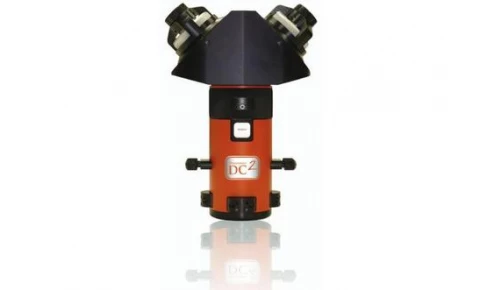Photometrics DC2 - Dual-Channel Simultaneous-Imaging System
For pricing, technical or any other questions please contact the supplier
- No registration required
- No markups, no fees
- Direct contact with supplier
-
Ships from:
United States
-
Sold by:
Photometrics -
On FindLight:
since 2015
Description
The Photometrics® DC2™ is a cutting-edge dual-channel, full-field, simultaneous-imaging system specifically designed for life sciences applications. This advanced system allows for the simultaneous acquisition of two full-field emission images, providing researchers with the ability to capture data based on two distinct wavelengths or polarizations. By projecting each channel onto an individual CCD, the DC2™ ensures high precision and accuracy, making it an essential tool for quantitative emission ratiometric imaging.
Designed to integrate seamlessly with most microscopes, the DC2™ enhances the efficiency and speed of high-content screening applications. Its innovative design includes an exchangeable filter cube, allowing users to switch between multiple applications with minimal realignment. This feature is particularly beneficial in dynamic research environments where versatility and adaptability are crucial. Additionally, the DC2™ offers improved adjustment control, facilitating easier image alignment and ensuring optimal performance across various experimental setups.
The system's robust construction includes an integrated, adjustable CCD mask to minimize ghosting, and independent focus adjustment for each camera, providing researchers with unparalleled control over their imaging processes. The Photometrics® DC2™ is compatible with many Photometrics® and QImaging® cameras, although compatibility testing is recommended for certain microscope and objective configurations. With its comprehensive set of features and user-friendly design, the DC2™ stands out as a premier choice for researchers seeking high-performance imaging solutions in the life sciences sector.
Photometrics DC2 - Dual-Channel Simultaneous-Imaging System
Specifications |
|
|---|---|
| Number Of Channels: | 2 |
| Sensor Type: | CCD |
| Wavelength Range: | 400 – 750 nm |
| Efficiency Per Image: | 88 to 92% |
| Operation Temperature: | 10 to 37˚C |
| Detector Attachment: | C-mount (male) |
| Front Attachment: | C-mount (female) |
| External Mounting Option: | ¼-20 tapped hole on back of unit |
| Dimensions: | 6.5” at widest point x 8.5” height |
| Weight: | 4.8 lbs |
| Filters: | Emission/barrier, neutral density, polarization; 1” (25.4-mm) max diameter; 0.39” (9.9-mm) max thickness |
Features
- Simultaneous Acquisition: Capture two full-field emission images simultaneously.
- Versatile Emission Separation: Separate emissions by wavelength, polarization, or amplitude.
- Enhanced Scanning Speeds: Double the scanning speeds in high-content screening applications.
- Easy Mounting: Compatible with most microscopes for quick setup.
- Improved Image Alignment: Enhanced adjustment control for easier alignment.
- Exchangeable Filter Cube: Supports multiple applications with minimal realignment.
- Bypass Mode: Direct all emission light to a single camera if needed.
- Integrated Adjustable CCD Mask: Minimizes ghosting for clearer images.
- Independent Focus Adjustment: Separate focus settings for each camera.
- Camera Compatibility: Works with many Photometrics® and QImaging® cameras.*
- Wavelength Sensitivity: 400 to 750 nm range for broad application support.
- High Efficiency: Image efficiency ranges from 88 to 92%.
- Operational Temperature Range: Operates efficiently between 10 to 37˚C.
- Flexible Attachments: C-mount (male) detector attachment and C-mount (female) front attachment.
- External Mounting Option: ¼-20 tapped hole on the back of the unit for secure mounting.
- Compact Design: Dimensions of 6.5” at the widest point x 8.5” height and weighs 4.8 lbs.
- Filter Compatibility: Supports emission/barrier, neutral density, and polarization filters with a max diameter of 1” (25.4-mm) and max thickness of 0.39” (9.9-mm).
- Patented Technology: Protected by multiple patents in the USA, Australia, and Canada.
Applications
- FRET Imaging: Enables quantitative fluorescence resonance energy transfer imaging.
- Calcium Imaging: Ideal for dual-emission calcium indicators such as fluo-3/Fura Red™ or indo-1.
- Fluorescence Polarization Studies: Supports anisotropy imaging for molecular dynamics analysis.
- Simultaneous Fluorescence/DIC Imaging: Facilitates combined imaging techniques for detailed cellular observation.
- Single-Molecule Fluorescence (SMF) Imaging: Enhances detection sensitivity for single-molecule analysis.
- Multiwavelength TIRF Imaging: Supports total internal reflection fluorescence imaging across wavelengths.
- Voltage and pH Sensing: Compatible with di-4-ANEPPS voltage sensors and SNARF pH indicators.
- Drug Discovery and FISH Imaging: Effective in Cy3/Cy5 drug screening and fluorescence in situ hybridization.
Frequently Asked Questions
The Photometrics DC2 can be used for fluorescence resonance energy transfer (FRET) imaging, calcium imaging with fluo-3/Fura Red or dual-emission indo-1 imaging, fluorescence polarization/anisotropy imaging, simultaneous fluorescence/DIC imaging, drug discovery with Cy3/Cy5, single-molecule fluorescence (SMF) imaging, pH imaging with SNARF, multiwavelength total internal reflection fluorescence (TIRF) imaging, voltage sensing with di-4-ANEPPS, fluorescence in situ hybridization (FISH) imaging, and cAMP imaging with FICRhR.
The Photometrics DC2 has a wavelength sensitivity of 400 to 750 nm, efficiency per image of 88 to 92%, operation temperature of 10 to 37˚C, detector attachment of C-mount (male), front attachment of C-mount (female), external mounting option of ¼-20 tapped hole on back of unit, dimensions of 6.5” at widest point x 8.5” height, weight of 4.8 lbs, and filters for emission/barrier, neutral density, and polarization with 1” (25.4-mm) max diameter and 0.39” (9.9-mm) max thickness.
The Photometrics DC2 features simultaneous acquisition of two full-field emission images, emission separation by wavelength, polarization, or amplitude, increased scanning speeds, easy mounting to most microscopes, improved adjustment control, exchangeable filter cube, bypass mode, integrated adjustable CCD mask, independent focus adjustment for each camera, and compatibility with many Photometrics and QImaging cameras.
The Photometrics DC2 works with many Photometrics and QImaging cameras, but it is recommended that the DC2 be tested for compatibility with your system, particularly in some newer Olympus and Zeiss stand/objective configurations, to avoid vignetting. Please contact your local representative to verify compatibility with specific cameras.
The Photometrics DC2 is a dual-channel simultaneous-imaging system that enables two-channel simultaneous imaging based on two distinct wavelengths or polarizations.

